Critical Analysis of Inquiry Methods in Two Finance Research Papers
VerifiedAdded on 2022/08/25
|9
|2054
|21
Report
AI Summary
This report provides a critical analysis of the methodologies employed in two finance research papers. The analysis begins by identifying the epistemological stances of each paper, distinguishing between positivist and interpretivist approaches. Paper 1, focusing on the real effects of reporting key audit matters, is classified as positivist, utilizing an experimental approach to assess auditor judgment. Paper 2, examining social networks and corruption, adopts an interpretivist approach, employing qualitative methods like semi-structured interviews. The report then contrasts the ontological and axiological views underpinning each paper, examining how each paper views the nature of reality and the role of the researcher. The report further delves into the specific methodologies used, including experimental designs, case studies, and qualitative data collection techniques, highlighting their limitations and strengths. Finally, the report concludes by summarizing the key differences in research approaches and offering a comparative assessment of the overall methodologies used in the two papers, emphasizing the impact of these choices on the research findings and their generalizability.
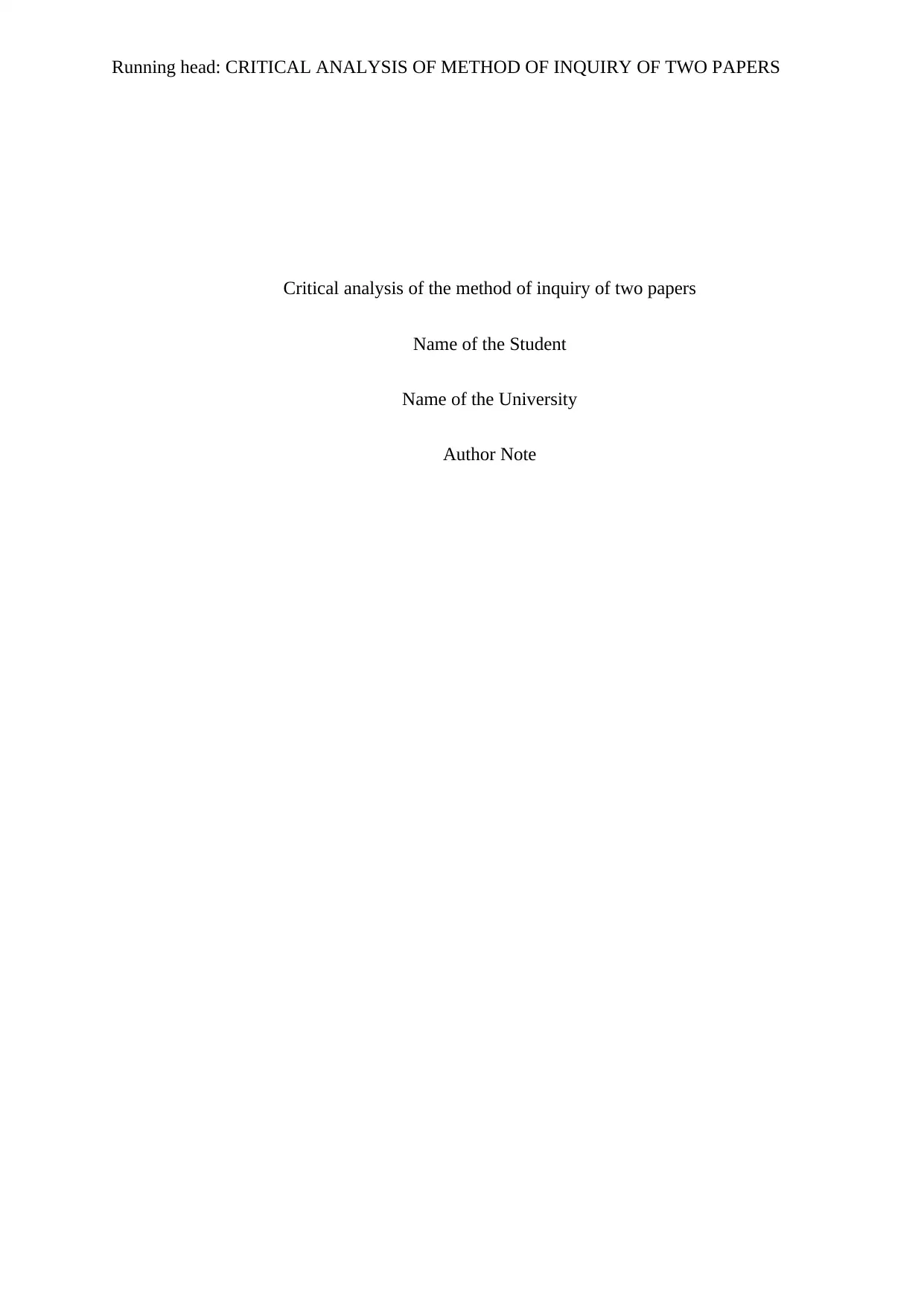
Running head: CRITICAL ANALYSIS OF METHOD OF INQUIRY OF TWO PAPERS
Critical analysis of the method of inquiry of two papers
Name of the Student
Name of the University
Author Note
Critical analysis of the method of inquiry of two papers
Name of the Student
Name of the University
Author Note
Paraphrase This Document
Need a fresh take? Get an instant paraphrase of this document with our AI Paraphraser
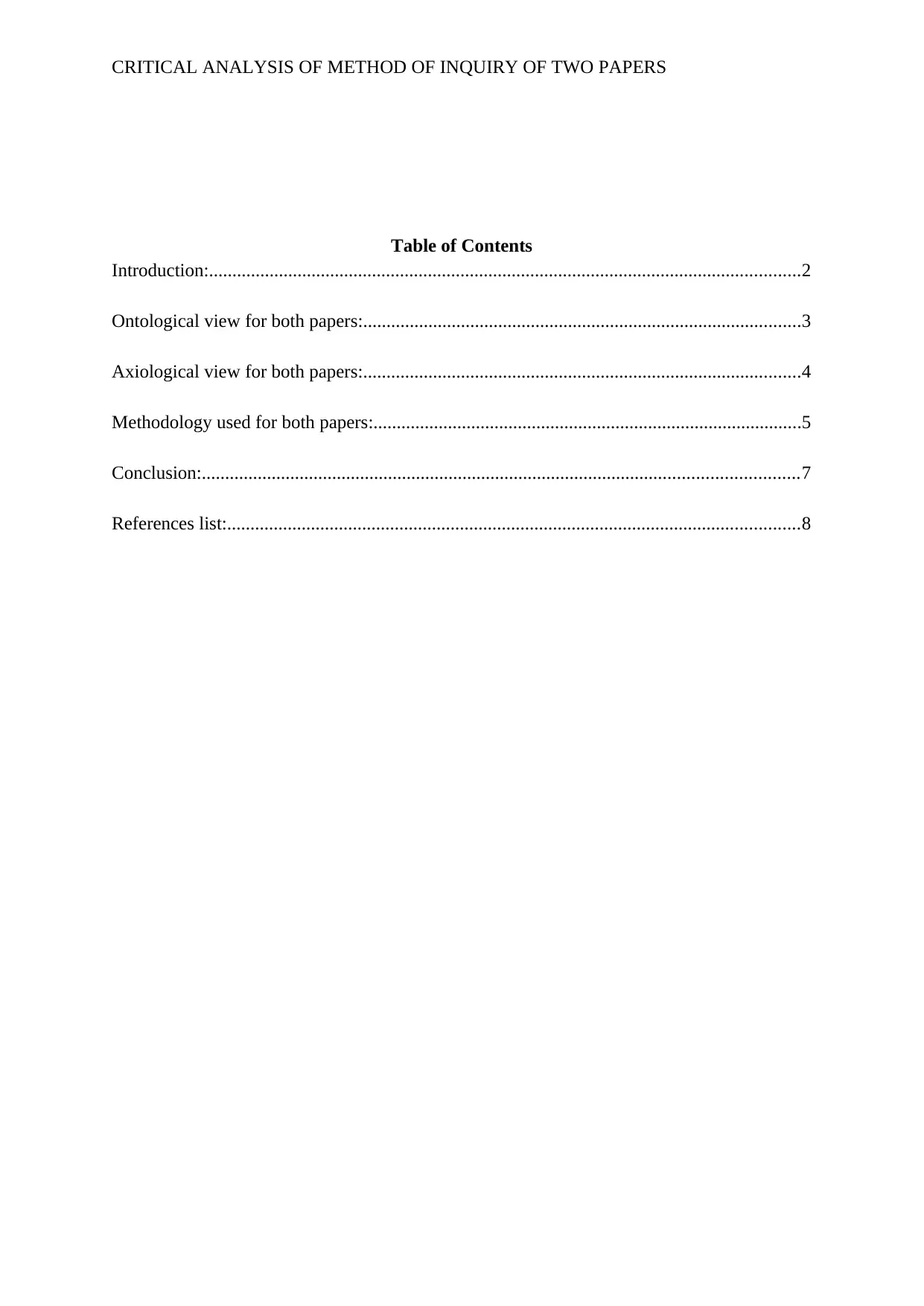
CRITICAL ANALYSIS OF METHOD OF INQUIRY OF TWO PAPERS
Table of Contents
Introduction:...............................................................................................................................2
Ontological view for both papers:..............................................................................................3
Axiological view for both papers:..............................................................................................4
Methodology used for both papers:............................................................................................5
Conclusion:................................................................................................................................7
References list:...........................................................................................................................8
Table of Contents
Introduction:...............................................................................................................................2
Ontological view for both papers:..............................................................................................3
Axiological view for both papers:..............................................................................................4
Methodology used for both papers:............................................................................................5
Conclusion:................................................................................................................................7
References list:...........................................................................................................................8
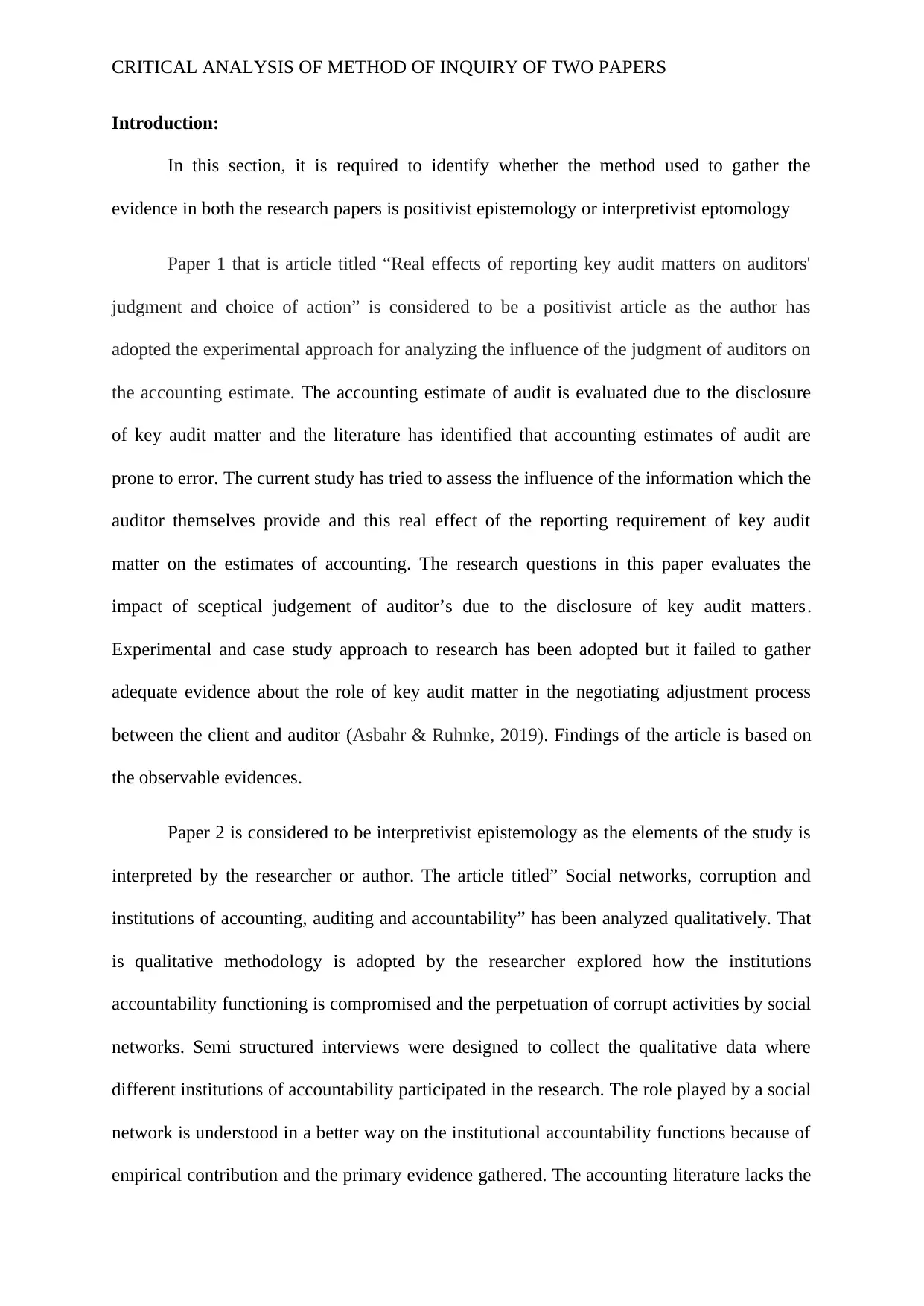
CRITICAL ANALYSIS OF METHOD OF INQUIRY OF TWO PAPERS
Introduction:
In this section, it is required to identify whether the method used to gather the
evidence in both the research papers is positivist epistemology or interpretivist eptomology
Paper 1 that is article titled “Real effects of reporting key audit matters on auditors'
judgment and choice of action” is considered to be a positivist article as the author has
adopted the experimental approach for analyzing the influence of the judgment of auditors on
the accounting estimate. The accounting estimate of audit is evaluated due to the disclosure
of key audit matter and the literature has identified that accounting estimates of audit are
prone to error. The current study has tried to assess the influence of the information which the
auditor themselves provide and this real effect of the reporting requirement of key audit
matter on the estimates of accounting. The research questions in this paper evaluates the
impact of sceptical judgement of auditor’s due to the disclosure of key audit matters.
Experimental and case study approach to research has been adopted but it failed to gather
adequate evidence about the role of key audit matter in the negotiating adjustment process
between the client and auditor (Asbahr & Ruhnke, 2019). Findings of the article is based on
the observable evidences.
Paper 2 is considered to be interpretivist epistemology as the elements of the study is
interpreted by the researcher or author. The article titled” Social networks, corruption and
institutions of accounting, auditing and accountability” has been analyzed qualitatively. That
is qualitative methodology is adopted by the researcher explored how the institutions
accountability functioning is compromised and the perpetuation of corrupt activities by social
networks. Semi structured interviews were designed to collect the qualitative data where
different institutions of accountability participated in the research. The role played by a social
network is understood in a better way on the institutional accountability functions because of
empirical contribution and the primary evidence gathered. The accounting literature lacks the
Introduction:
In this section, it is required to identify whether the method used to gather the
evidence in both the research papers is positivist epistemology or interpretivist eptomology
Paper 1 that is article titled “Real effects of reporting key audit matters on auditors'
judgment and choice of action” is considered to be a positivist article as the author has
adopted the experimental approach for analyzing the influence of the judgment of auditors on
the accounting estimate. The accounting estimate of audit is evaluated due to the disclosure
of key audit matter and the literature has identified that accounting estimates of audit are
prone to error. The current study has tried to assess the influence of the information which the
auditor themselves provide and this real effect of the reporting requirement of key audit
matter on the estimates of accounting. The research questions in this paper evaluates the
impact of sceptical judgement of auditor’s due to the disclosure of key audit matters.
Experimental and case study approach to research has been adopted but it failed to gather
adequate evidence about the role of key audit matter in the negotiating adjustment process
between the client and auditor (Asbahr & Ruhnke, 2019). Findings of the article is based on
the observable evidences.
Paper 2 is considered to be interpretivist epistemology as the elements of the study is
interpreted by the researcher or author. The article titled” Social networks, corruption and
institutions of accounting, auditing and accountability” has been analyzed qualitatively. That
is qualitative methodology is adopted by the researcher explored how the institutions
accountability functioning is compromised and the perpetuation of corrupt activities by social
networks. Semi structured interviews were designed to collect the qualitative data where
different institutions of accountability participated in the research. The role played by a social
network is understood in a better way on the institutional accountability functions because of
empirical contribution and the primary evidence gathered. The accounting literature lacks the
⊘ This is a preview!⊘
Do you want full access?
Subscribe today to unlock all pages.

Trusted by 1+ million students worldwide
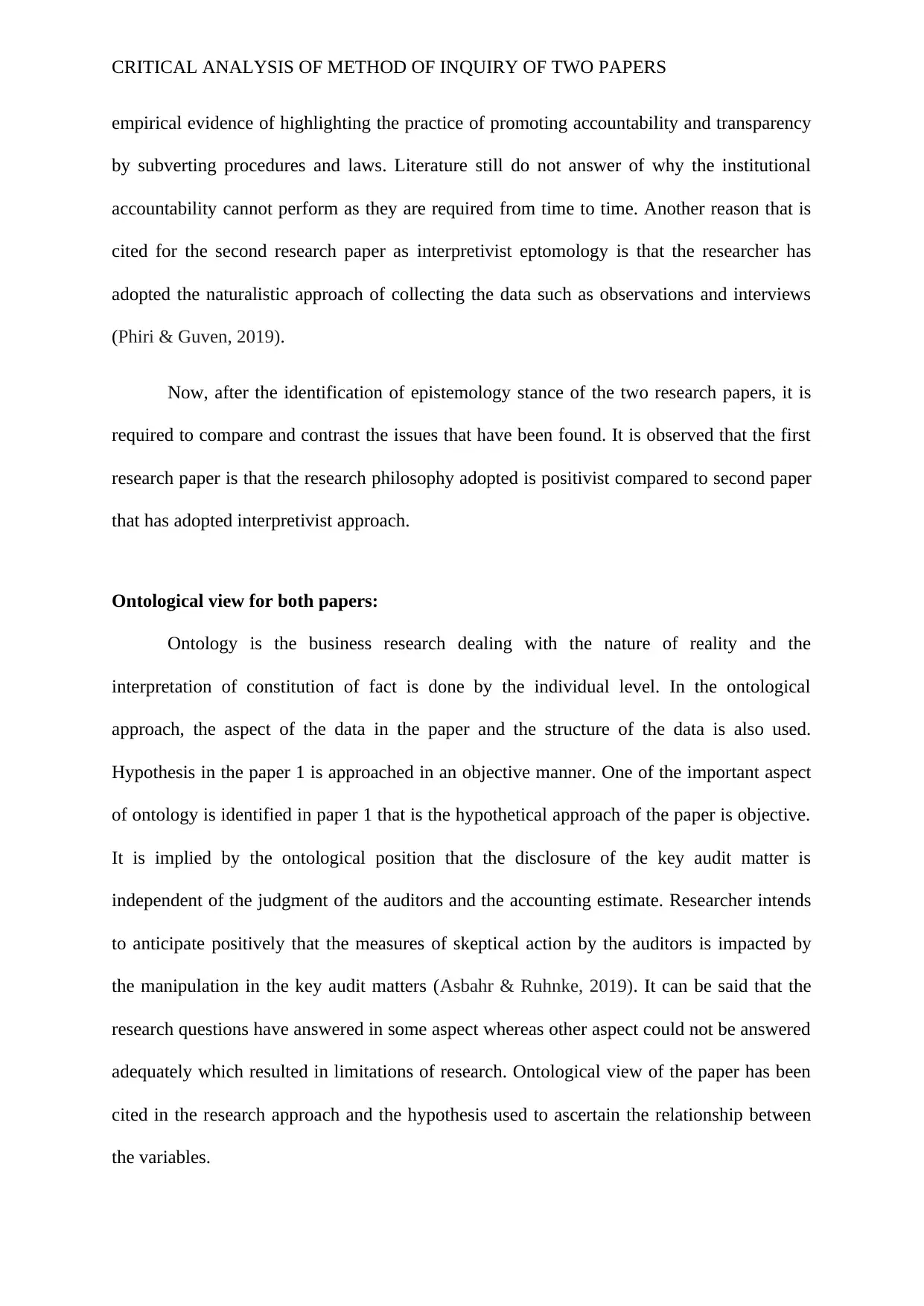
CRITICAL ANALYSIS OF METHOD OF INQUIRY OF TWO PAPERS
empirical evidence of highlighting the practice of promoting accountability and transparency
by subverting procedures and laws. Literature still do not answer of why the institutional
accountability cannot perform as they are required from time to time. Another reason that is
cited for the second research paper as interpretivist eptomology is that the researcher has
adopted the naturalistic approach of collecting the data such as observations and interviews
(Phiri & Guven, 2019).
Now, after the identification of epistemology stance of the two research papers, it is
required to compare and contrast the issues that have been found. It is observed that the first
research paper is that the research philosophy adopted is positivist compared to second paper
that has adopted interpretivist approach.
Ontological view for both papers:
Ontology is the business research dealing with the nature of reality and the
interpretation of constitution of fact is done by the individual level. In the ontological
approach, the aspect of the data in the paper and the structure of the data is also used.
Hypothesis in the paper 1 is approached in an objective manner. One of the important aspect
of ontology is identified in paper 1 that is the hypothetical approach of the paper is objective.
It is implied by the ontological position that the disclosure of the key audit matter is
independent of the judgment of the auditors and the accounting estimate. Researcher intends
to anticipate positively that the measures of skeptical action by the auditors is impacted by
the manipulation in the key audit matters (Asbahr & Ruhnke, 2019). It can be said that the
research questions have answered in some aspect whereas other aspect could not be answered
adequately which resulted in limitations of research. Ontological view of the paper has been
cited in the research approach and the hypothesis used to ascertain the relationship between
the variables.
empirical evidence of highlighting the practice of promoting accountability and transparency
by subverting procedures and laws. Literature still do not answer of why the institutional
accountability cannot perform as they are required from time to time. Another reason that is
cited for the second research paper as interpretivist eptomology is that the researcher has
adopted the naturalistic approach of collecting the data such as observations and interviews
(Phiri & Guven, 2019).
Now, after the identification of epistemology stance of the two research papers, it is
required to compare and contrast the issues that have been found. It is observed that the first
research paper is that the research philosophy adopted is positivist compared to second paper
that has adopted interpretivist approach.
Ontological view for both papers:
Ontology is the business research dealing with the nature of reality and the
interpretation of constitution of fact is done by the individual level. In the ontological
approach, the aspect of the data in the paper and the structure of the data is also used.
Hypothesis in the paper 1 is approached in an objective manner. One of the important aspect
of ontology is identified in paper 1 that is the hypothetical approach of the paper is objective.
It is implied by the ontological position that the disclosure of the key audit matter is
independent of the judgment of the auditors and the accounting estimate. Researcher intends
to anticipate positively that the measures of skeptical action by the auditors is impacted by
the manipulation in the key audit matters (Asbahr & Ruhnke, 2019). It can be said that the
research questions have answered in some aspect whereas other aspect could not be answered
adequately which resulted in limitations of research. Ontological view of the paper has been
cited in the research approach and the hypothesis used to ascertain the relationship between
the variables.
Paraphrase This Document
Need a fresh take? Get an instant paraphrase of this document with our AI Paraphraser
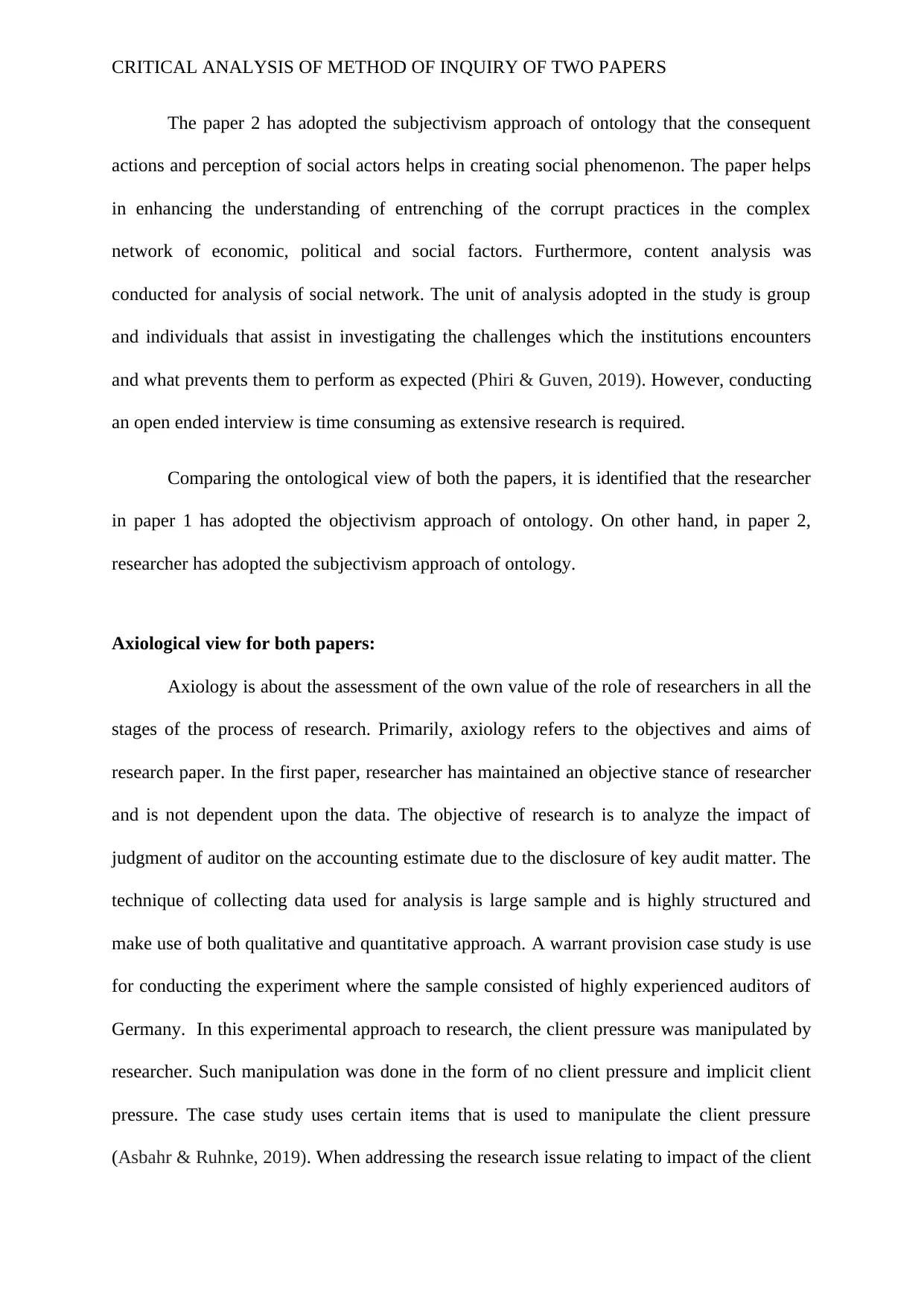
CRITICAL ANALYSIS OF METHOD OF INQUIRY OF TWO PAPERS
The paper 2 has adopted the subjectivism approach of ontology that the consequent
actions and perception of social actors helps in creating social phenomenon. The paper helps
in enhancing the understanding of entrenching of the corrupt practices in the complex
network of economic, political and social factors. Furthermore, content analysis was
conducted for analysis of social network. The unit of analysis adopted in the study is group
and individuals that assist in investigating the challenges which the institutions encounters
and what prevents them to perform as expected (Phiri & Guven, 2019). However, conducting
an open ended interview is time consuming as extensive research is required.
Comparing the ontological view of both the papers, it is identified that the researcher
in paper 1 has adopted the objectivism approach of ontology. On other hand, in paper 2,
researcher has adopted the subjectivism approach of ontology.
Axiological view for both papers:
Axiology is about the assessment of the own value of the role of researchers in all the
stages of the process of research. Primarily, axiology refers to the objectives and aims of
research paper. In the first paper, researcher has maintained an objective stance of researcher
and is not dependent upon the data. The objective of research is to analyze the impact of
judgment of auditor on the accounting estimate due to the disclosure of key audit matter. The
technique of collecting data used for analysis is large sample and is highly structured and
make use of both qualitative and quantitative approach. A warrant provision case study is use
for conducting the experiment where the sample consisted of highly experienced auditors of
Germany. In this experimental approach to research, the client pressure was manipulated by
researcher. Such manipulation was done in the form of no client pressure and implicit client
pressure. The case study uses certain items that is used to manipulate the client pressure
(Asbahr & Ruhnke, 2019). When addressing the research issue relating to impact of the client
The paper 2 has adopted the subjectivism approach of ontology that the consequent
actions and perception of social actors helps in creating social phenomenon. The paper helps
in enhancing the understanding of entrenching of the corrupt practices in the complex
network of economic, political and social factors. Furthermore, content analysis was
conducted for analysis of social network. The unit of analysis adopted in the study is group
and individuals that assist in investigating the challenges which the institutions encounters
and what prevents them to perform as expected (Phiri & Guven, 2019). However, conducting
an open ended interview is time consuming as extensive research is required.
Comparing the ontological view of both the papers, it is identified that the researcher
in paper 1 has adopted the objectivism approach of ontology. On other hand, in paper 2,
researcher has adopted the subjectivism approach of ontology.
Axiological view for both papers:
Axiology is about the assessment of the own value of the role of researchers in all the
stages of the process of research. Primarily, axiology refers to the objectives and aims of
research paper. In the first paper, researcher has maintained an objective stance of researcher
and is not dependent upon the data. The objective of research is to analyze the impact of
judgment of auditor on the accounting estimate due to the disclosure of key audit matter. The
technique of collecting data used for analysis is large sample and is highly structured and
make use of both qualitative and quantitative approach. A warrant provision case study is use
for conducting the experiment where the sample consisted of highly experienced auditors of
Germany. In this experimental approach to research, the client pressure was manipulated by
researcher. Such manipulation was done in the form of no client pressure and implicit client
pressure. The case study uses certain items that is used to manipulate the client pressure
(Asbahr & Ruhnke, 2019). When addressing the research issue relating to impact of the client
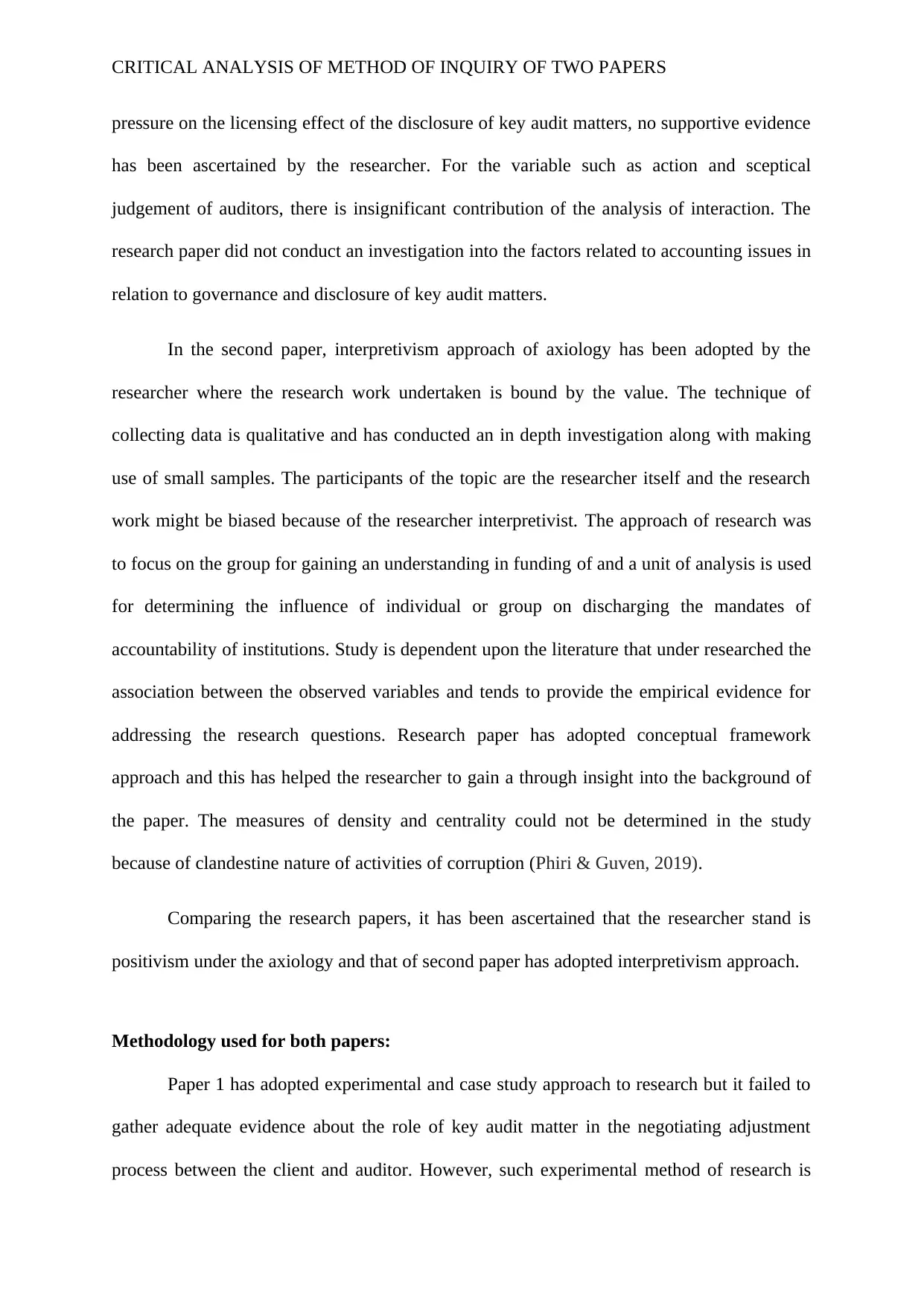
CRITICAL ANALYSIS OF METHOD OF INQUIRY OF TWO PAPERS
pressure on the licensing effect of the disclosure of key audit matters, no supportive evidence
has been ascertained by the researcher. For the variable such as action and sceptical
judgement of auditors, there is insignificant contribution of the analysis of interaction. The
research paper did not conduct an investigation into the factors related to accounting issues in
relation to governance and disclosure of key audit matters.
In the second paper, interpretivism approach of axiology has been adopted by the
researcher where the research work undertaken is bound by the value. The technique of
collecting data is qualitative and has conducted an in depth investigation along with making
use of small samples. The participants of the topic are the researcher itself and the research
work might be biased because of the researcher interpretivist. The approach of research was
to focus on the group for gaining an understanding in funding of and a unit of analysis is used
for determining the influence of individual or group on discharging the mandates of
accountability of institutions. Study is dependent upon the literature that under researched the
association between the observed variables and tends to provide the empirical evidence for
addressing the research questions. Research paper has adopted conceptual framework
approach and this has helped the researcher to gain a through insight into the background of
the paper. The measures of density and centrality could not be determined in the study
because of clandestine nature of activities of corruption (Phiri & Guven, 2019).
Comparing the research papers, it has been ascertained that the researcher stand is
positivism under the axiology and that of second paper has adopted interpretivism approach.
Methodology used for both papers:
Paper 1 has adopted experimental and case study approach to research but it failed to
gather adequate evidence about the role of key audit matter in the negotiating adjustment
process between the client and auditor. However, such experimental method of research is
pressure on the licensing effect of the disclosure of key audit matters, no supportive evidence
has been ascertained by the researcher. For the variable such as action and sceptical
judgement of auditors, there is insignificant contribution of the analysis of interaction. The
research paper did not conduct an investigation into the factors related to accounting issues in
relation to governance and disclosure of key audit matters.
In the second paper, interpretivism approach of axiology has been adopted by the
researcher where the research work undertaken is bound by the value. The technique of
collecting data is qualitative and has conducted an in depth investigation along with making
use of small samples. The participants of the topic are the researcher itself and the research
work might be biased because of the researcher interpretivist. The approach of research was
to focus on the group for gaining an understanding in funding of and a unit of analysis is used
for determining the influence of individual or group on discharging the mandates of
accountability of institutions. Study is dependent upon the literature that under researched the
association between the observed variables and tends to provide the empirical evidence for
addressing the research questions. Research paper has adopted conceptual framework
approach and this has helped the researcher to gain a through insight into the background of
the paper. The measures of density and centrality could not be determined in the study
because of clandestine nature of activities of corruption (Phiri & Guven, 2019).
Comparing the research papers, it has been ascertained that the researcher stand is
positivism under the axiology and that of second paper has adopted interpretivism approach.
Methodology used for both papers:
Paper 1 has adopted experimental and case study approach to research but it failed to
gather adequate evidence about the role of key audit matter in the negotiating adjustment
process between the client and auditor. However, such experimental method of research is
⊘ This is a preview!⊘
Do you want full access?
Subscribe today to unlock all pages.

Trusted by 1+ million students worldwide
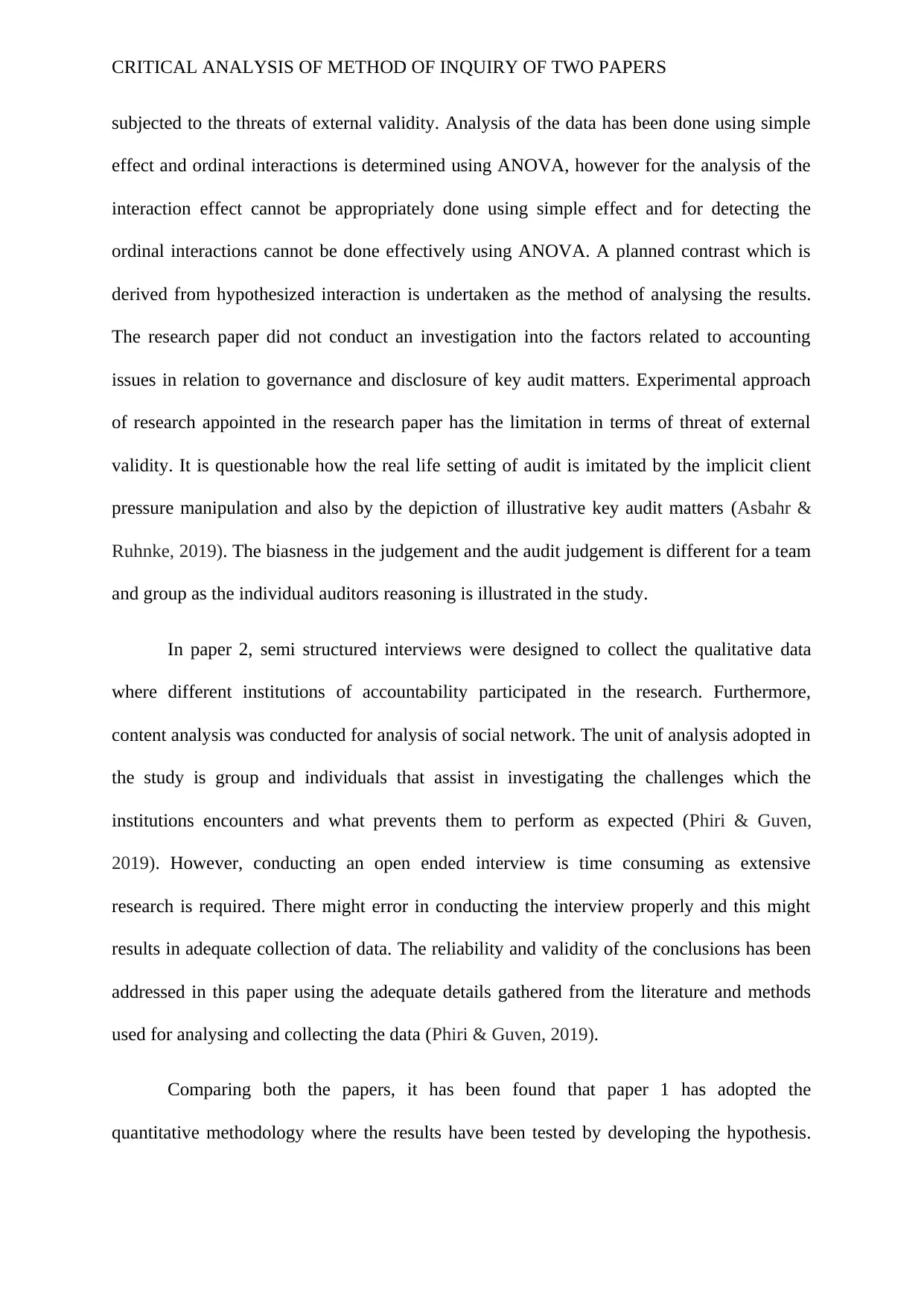
CRITICAL ANALYSIS OF METHOD OF INQUIRY OF TWO PAPERS
subjected to the threats of external validity. Analysis of the data has been done using simple
effect and ordinal interactions is determined using ANOVA, however for the analysis of the
interaction effect cannot be appropriately done using simple effect and for detecting the
ordinal interactions cannot be done effectively using ANOVA. A planned contrast which is
derived from hypothesized interaction is undertaken as the method of analysing the results.
The research paper did not conduct an investigation into the factors related to accounting
issues in relation to governance and disclosure of key audit matters. Experimental approach
of research appointed in the research paper has the limitation in terms of threat of external
validity. It is questionable how the real life setting of audit is imitated by the implicit client
pressure manipulation and also by the depiction of illustrative key audit matters (Asbahr &
Ruhnke, 2019). The biasness in the judgement and the audit judgement is different for a team
and group as the individual auditors reasoning is illustrated in the study.
In paper 2, semi structured interviews were designed to collect the qualitative data
where different institutions of accountability participated in the research. Furthermore,
content analysis was conducted for analysis of social network. The unit of analysis adopted in
the study is group and individuals that assist in investigating the challenges which the
institutions encounters and what prevents them to perform as expected (Phiri & Guven,
2019). However, conducting an open ended interview is time consuming as extensive
research is required. There might error in conducting the interview properly and this might
results in adequate collection of data. The reliability and validity of the conclusions has been
addressed in this paper using the adequate details gathered from the literature and methods
used for analysing and collecting the data (Phiri & Guven, 2019).
Comparing both the papers, it has been found that paper 1 has adopted the
quantitative methodology where the results have been tested by developing the hypothesis.
subjected to the threats of external validity. Analysis of the data has been done using simple
effect and ordinal interactions is determined using ANOVA, however for the analysis of the
interaction effect cannot be appropriately done using simple effect and for detecting the
ordinal interactions cannot be done effectively using ANOVA. A planned contrast which is
derived from hypothesized interaction is undertaken as the method of analysing the results.
The research paper did not conduct an investigation into the factors related to accounting
issues in relation to governance and disclosure of key audit matters. Experimental approach
of research appointed in the research paper has the limitation in terms of threat of external
validity. It is questionable how the real life setting of audit is imitated by the implicit client
pressure manipulation and also by the depiction of illustrative key audit matters (Asbahr &
Ruhnke, 2019). The biasness in the judgement and the audit judgement is different for a team
and group as the individual auditors reasoning is illustrated in the study.
In paper 2, semi structured interviews were designed to collect the qualitative data
where different institutions of accountability participated in the research. Furthermore,
content analysis was conducted for analysis of social network. The unit of analysis adopted in
the study is group and individuals that assist in investigating the challenges which the
institutions encounters and what prevents them to perform as expected (Phiri & Guven,
2019). However, conducting an open ended interview is time consuming as extensive
research is required. There might error in conducting the interview properly and this might
results in adequate collection of data. The reliability and validity of the conclusions has been
addressed in this paper using the adequate details gathered from the literature and methods
used for analysing and collecting the data (Phiri & Guven, 2019).
Comparing both the papers, it has been found that paper 1 has adopted the
quantitative methodology where the results have been tested by developing the hypothesis.
Paraphrase This Document
Need a fresh take? Get an instant paraphrase of this document with our AI Paraphraser
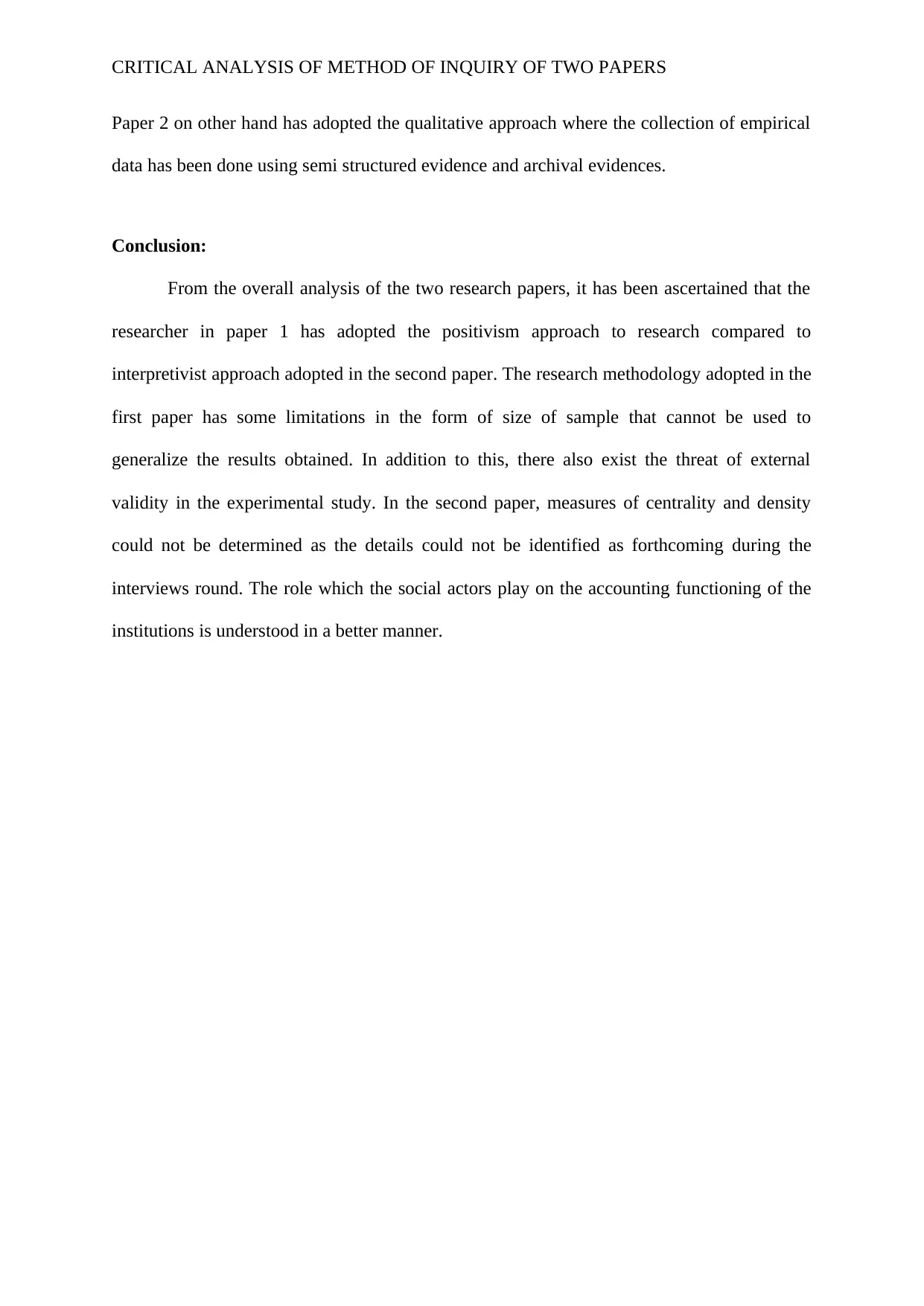
CRITICAL ANALYSIS OF METHOD OF INQUIRY OF TWO PAPERS
Paper 2 on other hand has adopted the qualitative approach where the collection of empirical
data has been done using semi structured evidence and archival evidences.
Conclusion:
From the overall analysis of the two research papers, it has been ascertained that the
researcher in paper 1 has adopted the positivism approach to research compared to
interpretivist approach adopted in the second paper. The research methodology adopted in the
first paper has some limitations in the form of size of sample that cannot be used to
generalize the results obtained. In addition to this, there also exist the threat of external
validity in the experimental study. In the second paper, measures of centrality and density
could not be determined as the details could not be identified as forthcoming during the
interviews round. The role which the social actors play on the accounting functioning of the
institutions is understood in a better manner.
Paper 2 on other hand has adopted the qualitative approach where the collection of empirical
data has been done using semi structured evidence and archival evidences.
Conclusion:
From the overall analysis of the two research papers, it has been ascertained that the
researcher in paper 1 has adopted the positivism approach to research compared to
interpretivist approach adopted in the second paper. The research methodology adopted in the
first paper has some limitations in the form of size of sample that cannot be used to
generalize the results obtained. In addition to this, there also exist the threat of external
validity in the experimental study. In the second paper, measures of centrality and density
could not be determined as the details could not be identified as forthcoming during the
interviews round. The role which the social actors play on the accounting functioning of the
institutions is understood in a better manner.
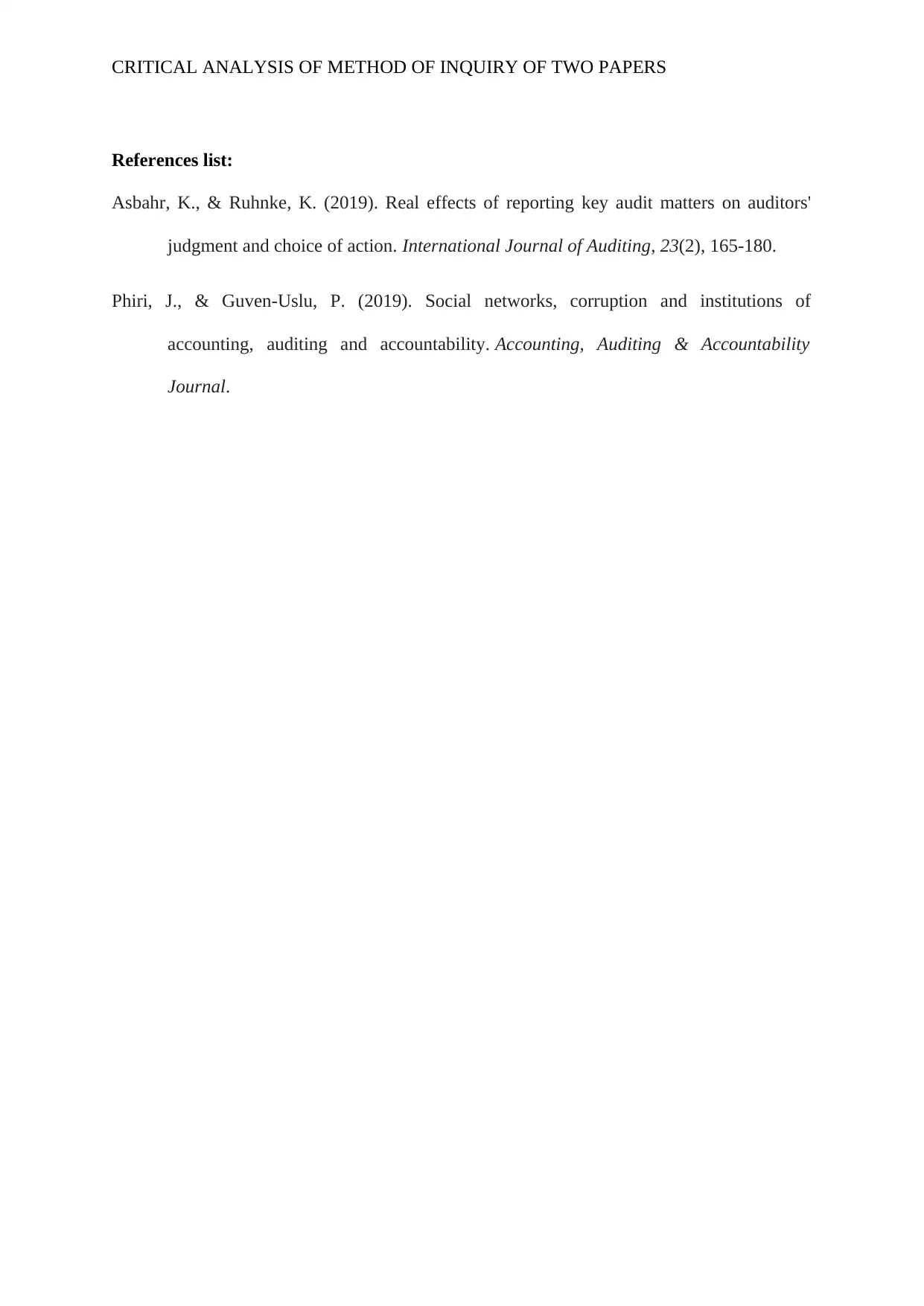
CRITICAL ANALYSIS OF METHOD OF INQUIRY OF TWO PAPERS
References list:
Asbahr, K., & Ruhnke, K. (2019). Real effects of reporting key audit matters on auditors'
judgment and choice of action. International Journal of Auditing, 23(2), 165-180.
Phiri, J., & Guven-Uslu, P. (2019). Social networks, corruption and institutions of
accounting, auditing and accountability. Accounting, Auditing & Accountability
Journal.
References list:
Asbahr, K., & Ruhnke, K. (2019). Real effects of reporting key audit matters on auditors'
judgment and choice of action. International Journal of Auditing, 23(2), 165-180.
Phiri, J., & Guven-Uslu, P. (2019). Social networks, corruption and institutions of
accounting, auditing and accountability. Accounting, Auditing & Accountability
Journal.
⊘ This is a preview!⊘
Do you want full access?
Subscribe today to unlock all pages.

Trusted by 1+ million students worldwide
1 out of 9
Your All-in-One AI-Powered Toolkit for Academic Success.
+13062052269
info@desklib.com
Available 24*7 on WhatsApp / Email
![[object Object]](/_next/static/media/star-bottom.7253800d.svg)
Unlock your academic potential
Copyright © 2020–2025 A2Z Services. All Rights Reserved. Developed and managed by ZUCOL.